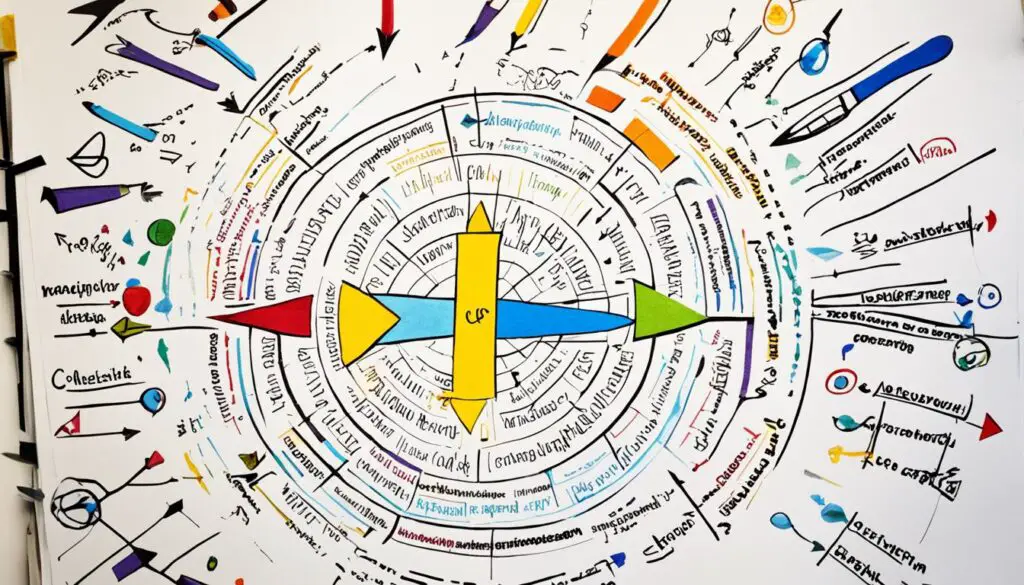Welcome to my article on Grounded Theory Research! I’ll give you an overview of its principles and procedures. This method lets us look at specific phenomena using real data to create new theories. It’s different from traditional methods because it starts with the data.
We collect data continuously and analyze it to create theories. Eventually, we have enough data for a solid theory. This is called reaching theoretical saturation. Grounded theory is great when there’s no existing theory or when current ones don’t cover everything.
We’ll talk about the pros and cons of grounded theory research and its history. Let’s explore why this method is so valuable!

Key Takeaways:
- Grounded theory research is a qualitative method that involves developing theories based on real-world data.
- It follows an inductive approach and is useful when there is no existing theory or when existing theories are incomplete.
- The process includes iterative data collection, analysis, and theory development until theoretical saturation is reached.
- Grounded theory research offers benefits like accurate representation of real-world settings and discovery of new theories.
- However, it also has limitations, such as challenges in participant recruitment and time-consuming data collection.
Understanding Grounded Theory
Grounded theory is a way for researchers to deeply understand a topic. It lets them uncover new theories based on real-life information. This method doesn’t start with guesses. It builds theories from what the data shows.
This method includes steps such as collecting, analyzing, and developing theories from data. It uses an iterative process. This means working on the data until it doesn’t add anything new to the theory being developed. This way, the theories stay very close to the data, showing a clear picture of reality.

It’s great for studying things where no theory exists yet or the current ones are not enough. Grounded theory allows researchers to find new solutions and knowledge. It’s very flexible for dealing with unknown topics in research.
One key strength of grounded theory is how it sparks new ideas. By deeply analyzing the data, researchers can find unexpected insights. This approach prevents researchers from focusing only on what they expect, thanks to the data driving the research.
Grounded theory also gives clear steps for analyzing the information. Methods like constant comparison keep the analysis unbiased and robust. Following these steps makes the findings reliable and helps ensure the quality of the research.
To sum up, grounded theory is a powerful tool for discovering new theories. It’s key for researchers wanting to understand topics deeply. By using an inductive approach and careful data analysis, they can create theories that truly reflect the real world.
Conducting Grounded Theory Research: Steps and Considerations
Doing grounded theory research follows some steps and thinking. The work is not strictly in a line. Instead, it’s back and forth, letting you gather and analyze data at the same time. Following these steps helps researchers get valuable findings.
Data Collection
The first step is to collect data. This can mean doing interviews, making observations, or looking at documents. It’s good to be open and willing to find new paths and ideas. Remember, the goal is to keep collecting data until you learn nothing new from it.
Data Analysis
Breaking down the data is very important. You need to organize and label the data to see patterns and themes. Keep an open mind to find new links between different bits of data. This stage often means you’ll be comparing your data a lot to fine-tune your theory.
Theoretical Sampling
Handpicking who or what you look at is a must in grounded theory. Rather than trying to cover everything, focus on gathering data that really helps your theory grow. This helps make your theory stronger and makes sure you really understand what you’re studying.
Constant Comparison
Comparing what you just learned with what you found before is a key part of this method. This way, you deepen your understanding and tweak your concepts. By always checking and rechecking, your theory stays on solid ground.
Memoing
Jotting down your thoughts and observations is essential. Use written notes or drawings. This helps your research improve your theory and serves as a very useful reference when you write up your findings.
Reflexivity
Thinking about your own biases is crucial. Being mindful of them helps you stay as neutral and objective as possible. This is critical for a solid research analysis.
Writing Up the Research
Finally, you need to write about what you’ve found. Explain your steps clearly and share how you’ve developed your theory. This makes your work more understandable and reliable to others.
Conducting grounded theory depends on following these steps closely. Doing so lets researchers tackle the dynamic process of grounded theory and uncover deep insights. Below is a summary of the key steps and considerations in conducting grounded theory research.
| Steps | Considerations |
|---|---|
| Data Collection | – Flexible approach – Aim for theoretical saturation |
| Data Analysis | – Systematic organization and coding – Open-minded exploration of connections – Constant comparison for pattern identification |
| Theoretical Sampling | – Purposeful sampling – Relevance to emerging concepts and categories |
| Constant Comparison | – Compare newly collected data with previous data – Identify similarities, differences, and variations |
| Memoing | – Document ideas, insights, and reflections – Aid in theory development and analysis |
| Reflexivity | – Acknowledge and reflect on researcher biases – Navigate potential biases for objective analysis |
| Writing Up the Research | – Organize data, analysis, and emerging theory – Present in a coherent and accessible manner |

Conclusion
Grounded theory research is a powerful way to study complex topics. It lets researchers look closely at real data to find new theories. This method is all about discovering new insights that truly reflect the facts we see.
Even though finding people to take part and gathering data can be hard, grounded theory is still a solid choice for research. It helps researchers dive deep into complicated topics in a step-by-step and careful way. This often leads to the discovery of fresh knowledge and theories.
To get the most out of grounded theory research, it’s crucial to know the steps and principles. Following the advice in this article can help researchers do their work well. This way, they can add to what we know in their areas of study.
FAQ
What is grounded theory research?
Grounded theory research is a way to study a certain thing or process closely. This method uses data from the real world to create new theories. It starts with collecting data and then finds theories within it.
Why is grounded theory research useful?
This type of research is helpful when there isn’t a theory already for what’s being looked at. It ensures studies reflect real life and the connection between findings and data is strong. Grounded theory helps find new theories and has clear ways to analyze and understand them.
What are the steps for conducting grounded theory research?
It involves collecting data, analyzing it, and developing theories repeatedly. These steps continue until no new insights come from the data. The work is not done in a straight line. Data gathering and analysis happen together.
What are the limitations of grounded theory research?
Grounded theory research faces issues like finding participants, the time it takes to collect data, and analysis difficulties. But, these challenges can be handled with good planning and executing the research process carefully.
How does grounded theory research contribute to the field?
It offers a solid and disciplined way to explore complex topics and create new theories with actual data. This allows researchers to move their fields forward by revealing new insights and knowledge.






